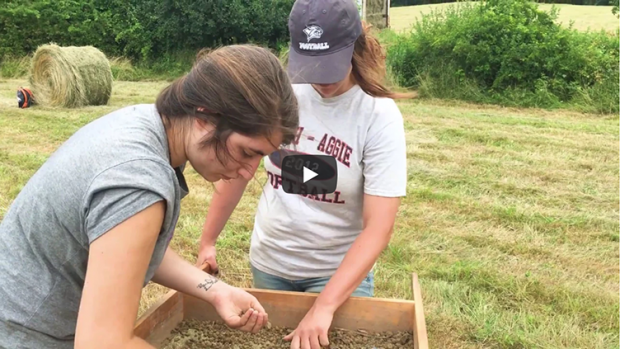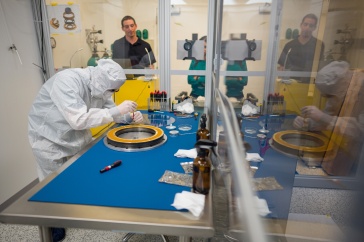
Of the many forces influencing the fate of the Great Bay estuary during the past century — development, industry, climate change, resource depletion — perhaps none has made a greater impact than UNH. Less than a mile from the banks of the Oyster River, with its Jackson Estuarine Laboratory jutting into the estuary on Adams Point and its Judd Gregg Marine Research Complex downstream at the mouth of the Piscataqua River, UNH has applied its considerable scientific and cultural resources to the bay, seeking to understand its flora and fauna, its geology and hydrology and history. And in doing so, it’s made Great Bay even greater.
OYSTERS
“Remarkable.” That’s how Ray Grizzle, research professor of zoology, describes oysters, the focus of his research in Great Bay for two decades. “Yes, they’re tasty. But on top of that, in the last 30 years we’ve begun to discover their ecological role is fantastic,” he says, noting each briny bivalve’s capacity to filter up to 20 gallons of water per day. While Great Bay’s oyster population dropped dramatically in the 1990s, largely due to a disease, it’s now stabilized, thanks in part to 17 reef restoration projects led by Grizzle and his longtime research technician Krystin Ward. More recently, the team has shifted some of its focus to aquaculture, and 16 commercial oyster farms now thrive in Little Bay. As oyster consumption grows, the work of some UNH researchers aims to help predict future outbreaks and keep sickness off the raw bar. Great Bay is the canary in the Gulf of Maine coal mine when it comes to Vibrio parahaemolyticus (Vp), the bacterial pathogen that can sicken oyster lovers, says Steve Jones, research associate professor of natural resources, noting that incidents of anyone getting sick from Great Bay or Gulf of Maine oysters are almost unheard of, but oyster farmers just to the south are increasingly experiencing outbreaks and costly shellfish bed closures as waters warm. Jones and associate professor of microbiology Cheryl Whistler are attempting to understand how the changing environment of Great Bay is promoting the strains of Vp that make us sick. And Whistler recently developed a patent-pending method to detect the strains of Vp that cause most of the regional human illness.

HORSESHOE CRABS
Horseshoe crabs, those armored beasts that cover Great Bay’s shores in the spring spawning season, are dying to help us. The biomedical industry taps a unique property of their bright blue blood, extracted from live animals, to test injectable drugs and medical devices for contamination, saving millions of lives. To understand the toll this procedure takes on them, professor of biological sciences Win Watson and graduate student Meghan Owings bleed horseshoe crabs in the lab then fit them with devices that track their depth, location and activity after they’re released. They’ve found that between five and 30 percent of the animals die within a few days; others don’t die but are less active and less likely to spawn. Their work has shown it’s not just blood loss, but the bleeding combined with exposure to heat and air during transport that’s most stressful to the animals. Watson is hopeful this research, conducted with Plymouth State University, could improve the crabs’ survival outcomes. “These guys have been around for 450 million years. Do we really want to be the ones responsible for their demise?” he asks.
STORMWATER
Since 2004, UNH’s Stormwater Center has worked to protect Great Bay — and 42 other water bodies in communities across the globe — from an abundant, if surprising, source of pollution: rain. Called stormwater, the rain that washes over roads, parking lots, roofs and other impervious surfaces carries excess nitrogen from sources such as exhaust from cars, chemical fertilizers and even animal waste into the bay. “Our mission is to address that by cleaning up the water and putting it back in the ground,” says Stormwater Center program director Jamie Houle ’95, ‘15G. At its field facility on the edge of campus, the center has researched and tested 40-some systems and identified those that work best to keep nitrogen out of the bay. As a program of UNH’s Cooperative Extension, the center shares its expertise with communities in the estuary watershed to help them meet increasingly strict regulations for reducing nitrogen.
“Over time, the bay has shifted from being a maritime region focused on transportation and extraction — of oysters, timber, brick — to something we regard as a marine resource, to be understood and protected.”
— Jeffrey Bolster, UNH professor of history and editor of “Cross-Grained & Wily Waters” (2002), a book of essays on Great Bay and the Piscataqua region
TIDAL ENERGY
A team of UNH engineers seeks to harvest something new from Great Bay: power. The estuary boasts some of the strongest tidal currents in North America, making it the ideal lab for testing equipment that could generate energy from the ebb and flow. UNH’s Center for Ocean Renewable Energy deploys tidal turbines beneath the General Sullivan Bridge, where Little Bay meets the Piscataqua River. Further down river, turbines beneath the Memorial Bridge between Portsmouth, New Hampshire, and Kittery, Maine, harness the tides to power a suite of sensors that constantly monitor the health of that so-called “living bridge.”
DATA MONITORING
Joe Salisbury knows how fast the wind was blowing across Great Bay last week, how warm or salty the bay was yesterday and what concentrations of nitrogen, ammonia and phosphorous flowed into its waters after the last heavy rainstorm. Salisbury, research associate professor of oceanography in UNH’s Ocean Process Analysis Laboratory, keeps an eye on Great Bay via a large yellow buoy that bobs about a kilometer off Jackson Estuarine Laboratory, one of dozens in the Northeastern Regional Association of Coastal Ocean Observing Systems. For more than a decade, UNH has monitored changing conditions and health of the estuary by tracking a range of chemical and physical data that deliver good news as well as concerning trends. “Great Bay is ecologically important. The salt marshes and seagrass beds support a food chain that goes right up to seals,” says Salisbury. “But it’s an ecosystem that’s threatened by human pressures, so we want to monitor that.”
EELGRASS
Eelgrass may be the unsung hero of estuaries: The underwater flowering plant filters water of excess nutrients and contaminants, stabilizes the seabed and provides food and safe shelter to juvenile fish, crabs and lobsters. It’s no wonder Fred Short has made it his life’s work. Since 1984, the research professor of natural resources and marine science has studied Zostera marina in Great Bay, and since 2006 he’s watched it decline. “The beds aren’t thick and lush like they used to be,” Short says, noting that Great Bay has lost 60 percent of its eelgrass. Nitrogen seeping into the estuary through sewage treatment plants or runoff is a culprit; it promotes the growth of light-blocking, smothering algae. But as recent regulations reduce the nitrogen flowing into the estuary, the fate of eelgrass is starting to turn. “I’m very optimistic,” Short says.
UNH’s Great Bay research is supported by numerous sources, including the National Science Foundation, National Oceanic and Atmospheric Administration, National Aeronautics and Space Administration, National Institutes of Health and its N.H. INBRE (IDeA Network of Biomedical Research Excellence) program, New Hampshire Agricultural Experiment Station, New Hampshire Sea Grant, NH EPSCoR (Established Program to Stimulate Competitive Research), The Nature Conservancy, NERACOOS (Northeastern Regional Association of Coastal Ocean Observing Systems), UNH School of Marine Science and Ocean Engineering, UNH Center for the Humanities and the Piscataqua Region Estuaries Project.
-
Written By:
Beth Potier | UNH Marketing | beth.potier@unh.edu | 2-1566



















































